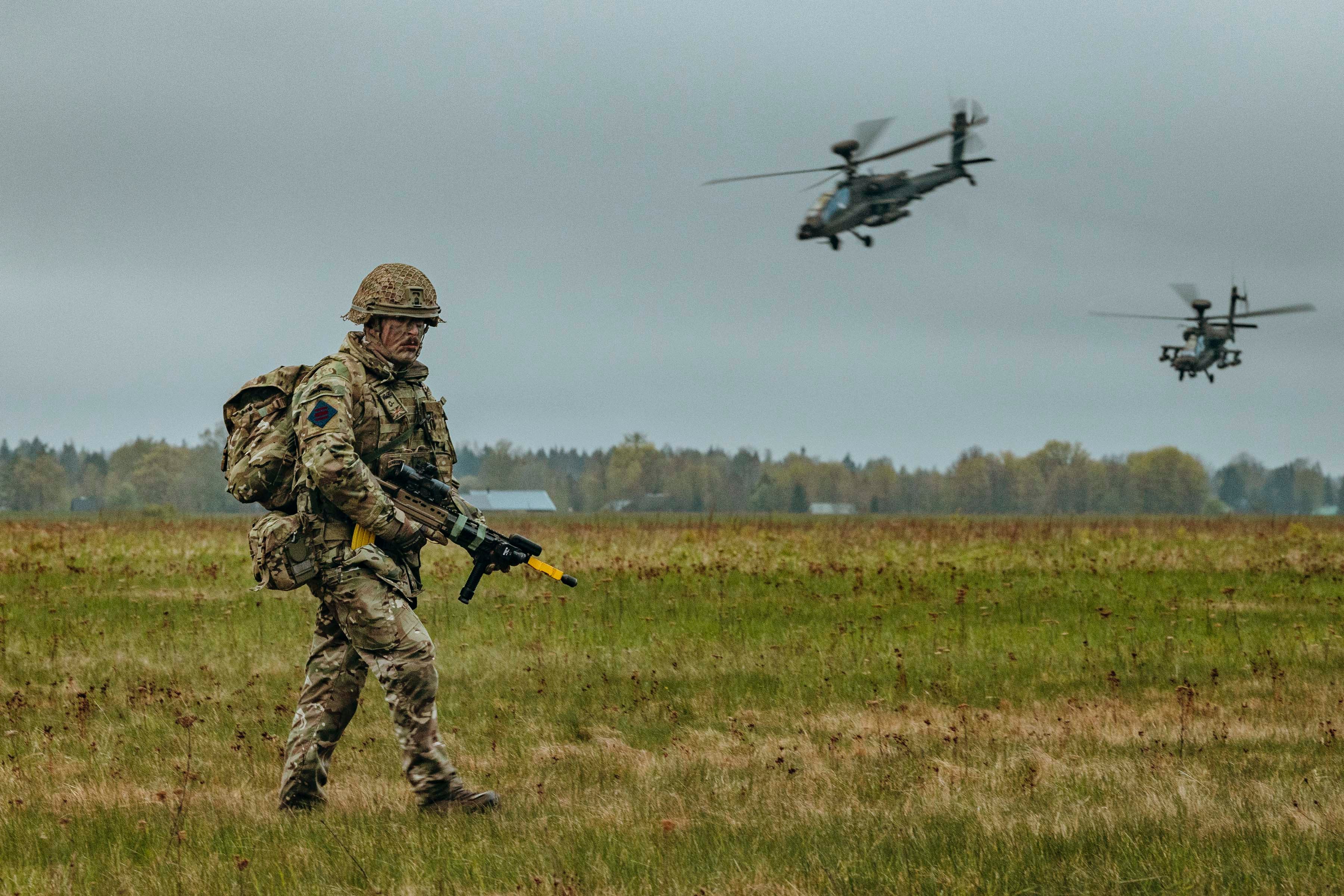British forces lead dramatic war games in Estonia as Nato seeks to counter Russia threat: ‘We are ready to fight’
Kim Sengupta reports from Nurmsi where he observes troops storming ‘Russian’ positions as part of Nato’s largest military exercises since the end of the Cold War


Apache helicopter gunships carry out strafing runs in support of troops on the ground storming Russian positions. A series of fortified trenches have been cleared in fierce close-quarter combat, and a counterattack repulsed with the use of drones and missiles.
The mission, Swift Response, is being carried out by British-led forces in Estonia as part of Nato’s biggest military exercises since the end of the Cold War, ranging from the Baltics to the Balkans. It comes amid an increasingly heated confrontation with Moscow following Vladimir Putin’s invasion of Ukraine.
There have been repeated warnings from the opposing sides, Nato and Moscow, of a potential conflagration. What is unfolding in Estonia are the opening salvoes of what a modern conflict between great powers would be like with the Western alliance making a stand on its eastern flank.
The stakes cannot be higher. President Putin has raised the possibility of nuclear weapons being used several times, as he has ratcheted up the rhetoric of warnings to the West since the start of the Ukraine war. The Nato response appears to be “prepare for the worst, hope for the best” while watching what the Kremlin does next.
Standing on a muddy field in Nurmsi in northern-central Estonia – a two-hour tank drive from the Russian border – Brigadier Giles Harris, the commander of British forces in the Baltic, has no doubt about the imperative of dealing with the clear and present threat from the Kremlin.
“It’s very urgent. I’m not going to second guess what may or may not happen, but as military personnel our job is to be ready. There is no point in waiting to be ready, we should get ready now. And what’s playing out in Ukraine provides us with the lessons that we need to learn”, he says.

“Our mindset is regardless of whether it’s today or tomorrow, or next year, we must be as ready as we can, we must make ourselves as ready as we can. We are prepared to defend every inch of Estonian land if necessary. In the minds of the soldiers, the strategic purpose and context in which we’re doing this training has definitely changed [from regular exercises]. The fact that we are doing this so close to Russia brings it home why it’s so important to be here.”
More than 90,000 troops from all 32 Nato member states are taking part in Exercise Steadfast Defender, of which Swift Response is a part, with drills including air assaults, armour manoeuvres and fire support taking place in locations including Estonia, Sweden, Poland, North Macedonia, Romania, Hungary and Moldova.
Brigadier Mark Berry, commander of the 16 Air Assault Brigade, in which the Parachute Regiment is a leading part, wanted to stress that the exercise was not just a show of force.
“I don’t consider any of the activities my soldiers conduct is ever a show. My role is to make sure that soldiers have the right training opportunities and feel ready and prepared to work together with allies or on their own,” he says.
“We do of course, send messages to whoever will listen. We want to make clear that our forces are ready ... [that] they’re capable of working with each other. In any specific time frame, when we are training we are looking for lessons from conflict zones, anywhere that has a lesson we can take.”

For Lieutenant Colonel David Lambert of the Army Air Corps this is a “landmark moment”.
“The training taking place is genuinely as realistic as it gets,” he says. “There is no artificiality in this. It’s just as good training from the lowest level all the way to the top. We are ready to fight today.”
What is happening in Ukraine is being analysed and used to calibrate the war games, from multiple ways to use drones and cyberwarfare, to countering mass advances of the type used by Russian forces in battles like the “meat grinder” of Bakhmut in the Donbas.
There are lessons in avoiding casualties as well. An example is the very large numbers of Russian commanders who have been killed in Ukraine. Kyiv claim a tally of 13: the Kremlin acknowledges seven.
One reason for this, according to analysts, is that the senior Russian officers often made themselves conspicuous targets by staying in one place with their vehicles – linked with antennas – parked together next to them.

Nato forces in the exercise are practising not being static at one position for too long, being mobile and ensuring that logistics are adequate and looking out for signs of being tracked by the enemy. Another means of avoidance being tried out is to move command and control of operations further back while ensuring that communications are maintained.
Troops from 16 Air Assault and other forces fighting Britain’s wars abroad have had their most recent experience of combat in Afghanistan and Iraq. Fighting a war in Europe presents different types of challenges, making exercises like Swift Response vital.
Different dynamics have led to different tactics.
The Weapons Mounted Installation Kit (WMIK) personnel carriers were much favoured by mobile British units including Special Forces. But their open tops and light armoured protection made them particularly vulnerable to roadside bombs and they were phased out of operations.
They have had a new lease of life with the Parachute Regiment. One reason is that they are light enough to be carried by transport aircraft or Chinook heavy-lift helicopters and can thus be rapidly deployed if, for instance, there is a Russian incursion across the border.
Standing next to a WMIK at Nurmsi, Corporal Ashis Thami said: “Of course we know what happened in Afghanistan. But we find it very useful in this kind of place to move around and provide force protection. We are told we must be ready for different wars in different times and I think that is right.”
Join our commenting forum
Join thought-provoking conversations, follow other Independent readers and see their replies
Comments